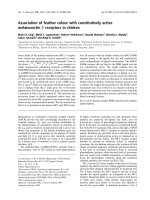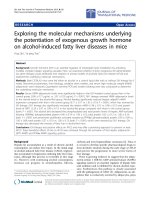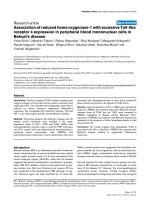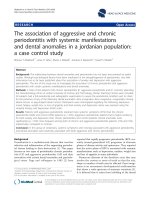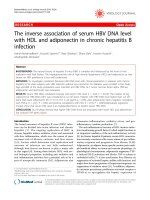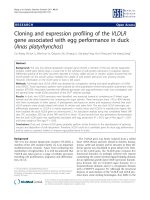Association of chicken growth hormone polymorphisms with egg production
Bạn đang xem bản rút gọn của tài liệu. Xem và tải ngay bản đầy đủ của tài liệu tại đây (631.51 KB, 11 trang )
Association of chicken growth hormone
polymorphisms with egg production
Y.J. Su1*, J.T. Shu1*, M. Zhang1, X.Y. Zhang1, Y.J. Shan1, G.H. Li1,
J.M. Yin1, W.T. Song1, H.F. Li1 and G.P. Zhao2
Institute of Poultry Science, Chinese Academy of Agricultural Sciences,
Yangzhou, China
2
Institute for Animal Sciences,
Chinese Academy of Agricultural Sciences, Beijing, China
1
*These authors contributed equally to this study.
Corresponding author: G.P. Zhao
E-mail: /
Genet. Mol. Res. 13 (3): 4893-4903 (2014)
Received April 8, 2013
Accepted November 21, 2013
Published July 4, 2014
DOI />
ABSTRACT. Growth hormone (GH) has diverse functions in animals,
together with other hormones from the somatotropic axis. Here, chicken
GH (cGH) was investigated in recessive white chickens and Qingyuan
partridge chickens as a candidate gene affecting egg production traits.
Chicken egg production traits were studied in association with 4
selected single nucleotide polymorphisms (T185G, G662A, T3094C,
and C3199T). Genotyping was performed by the polymerase chain
reaction-ligase detection reaction method. T185G was significantly
associated with the egg production traits of body weight at first egg
(BW), egg weight at first egg (EW), and the total egg production of
300-day old birds (EN 300). T3094C was also significantly associated
with certain egg production traits; however, it affected the 2 breeds
differently. Haplotypes of the 4 single nucleotide polymorphisms were
also significantly associated with egg production traits of chicken
age at first egg laying, BW, EW, and EN 300. H1H6 was the most
advantageous diplotype for egg production. We putatively concluded
Genetics and Molecular Research 13 (3): 4893-4903 (2014)
©FUNPEC-RP www.funpecrp.com.br
Y.J. Su et al.
4894
that polymorphisms in the cGH gene and its haplotypes could be used
as potential molecular markers for egg production traits to enhance the
breeding programs of indigenous chickens.
Key words: Growth hormone gene; Ligase detection reaction; Chicken;
Polymorphism; Egg production
INTRODUCTION
With its long history of animal husbandry and diversified geographical conditions, China has a wide variety of indigenous poultry resources. For instance, there are 108 native chicken
breeds in China (Chen et al., 2004). The majority of these chickens are composed of local and
fancy breeds characterized by medium to low performance. The Qingyuan partridge chicken
represents an important indigenous breed found in Qingyuan City, China. It is a light-bodytype breed with good meat quality, and is renowned for its 3 “yellow”, 2 “thin”, and 1 “partridge” morphological features, i.e., it has a yellow beak, shanks, and skin; a thin head and bone
structure; and partridge feathers. However, the Qingyuan partridge chicken has a relatively
slow growth rate, low egg production, and strong incubation behavior, with average annual egg
production of 78 (Xu and Chen, 2003). Therefore, breeders are searching for ways to improve
these traits to make this species more economically beneficial. The candidate gene approach
provides an effectual way to study the quantitative trait loci affecting these traits in chickens.
The growth hormone (GH) axis has a major influence on a diverse array of biological
processes, from the cellular level to whole-body phenotypic changes. Evidence for these effects has been provided by the study of transgenic animals, genetic disorders involving genes
of the GH axis, and the in vivo and in vitro administration of GH. Chicken growth hormone
(cGH) is a polypeptide hormone that is synthesized in and secreted by the pituitary gland.
This hormone is involved in a wide variety of physiological functions, such as growth, body
composition, egg production, aging, and reproduction. The cGH gene has been assigned to
chromosomal G-band region 1q4 (Shaw et al., 1991). The cGH gene contains 5 exons and 4
introns, like that of other mammalian GH genes. However, the cGH gene is significantly larger
compared to that of analogous mammalian genes, because of its intron size, which expands it
to 3.5 kb (Tanaka et al., 1992). Studies of White Leghorn and meat-type chickens using restriction fragment length polymorphism (RFLP) have shown that the GH gene is highly polymorphic in the intron region. In addition, alleles were identified that were involved in the selection
of a series of egg layers for egg production and in the selection of the size of the abdominal
fat pad in broilers (Fotouhi et al., 1993; Kuhnlein and Zadworny, 1994). Mou et al. (1995)
reported the presence of 2 MspI sites in chicken intron 1, with 1 MspI RFLP being established.
Kuhnlein et al. (1997) analyzed 12 noninbred strains of White Leghorn chicken by PCR-RFLP
at 3 MspI sites (PM1, PM2, and PM3) and 1 SacI site (PS1). These polymorphic sites were
located in intron 1, intron 3, and intron 4, respectively. The authors suggested that the alleles
that were located within the introns might have been selected for several reasons, such as an
array of egg production traits, resistance to Marek’s disease, or resistance to avian leukosis
(Kuhnlein et al., 1997; Feng et al., 1997). Nie et al. (2005) used denaturing high-performance
liquid chromatography to investigate 4 chicken breeds, and identified 283 SNPs from 12 genes
of the somatotropic axis that differed in growth and reproductive characteristics. Of these,
Genetics and Molecular Research 13 (3): 4893-4903 (2014)
©FUNPEC-RP www.funpecrp.com.br
Chicken egg production research
4895
46 SNPs were detected in the GH gene and MspI-RFLP in intron 1 had a G662A mutation,
while 2 MspI-RFLPs in intron 4 had T3094C and C3199T mutations. The authors also found
a T185G mutation in the 5'-UTR (the SNP location was based on the published cGH gene
sequence: GenBank accession No. AY461843).
In the present study, we describe a new, sensitive assay for the detection of the GH
gene, based on polymerase chain reaction-ligase detection reaction (PCR-LDR). LDR was
originally developed to discriminate single-base mutations and polymorphisms (Barany and
Gelfand, 1991). This technique utilizes the ability of DNA ligase to preferentially seal adjacent
oligonucleotides hybridized to target DNA, in which there is perfect complementation at the
nick junction (e.g., a missing phosphodiester bond).
In this study, PCR-LDR was used to genotype 4 previously reported polymorphisms
of the cGH gene (T185G, G662A, T3094C, and C3199T; Nie et al., 2005) for 2 chicken breeds
in China, Recessive white and Qingyuan partridge chicken. We aimed to evaluate the genetic
effects of variation in the GH gene on the egg production and reproduction traits of these 2
chicken breeds. The results are anticipated to generate potential molecular markers for egg
production and reproduction traits that might be used to enhance the breeding programs of
Qingyuan partridge chickens.
MATERIAL AND METHODS
Experimental animals
Blood samples of 136 Recessive White (RW) chickens and 187 Qingyuan partridge
(QY) chickens were randomly collected from the National Gene Pool for Indigenous Chicken
Breeds (Yangzhou, China) and Guangdong Tiannong Food Co. Ltd. (Guangzhou, China), respectively. All birds were housed in a stacked cage rearing system, with 1 cage for each bird.
Hens were fed a commercial corn-soy-bean-based diet with 16.5% crude protein and 2650
kcal/kg maintenance energy, and had free access to feed and water. The house was automatically ventilated, to maintain an ambient temperature of between 20° and 28°C, with a 16-h
light/day photoperiod at 15 lux. A number of parameters were documented for both breeds,
including the age at first egg (AFE), total egg production at 300 days of age (EN 300), body
weight at first egg (BW), and egg weight at first egg (EW). All procedures involving animals
were approved by the Animal Care and Use Committee at the Institute for Animal Sciences
(IAS), Chinese Academy of Agricultural Sciences (CAAS), where the experiment was conducted. All experimental procedures were performed according to authorization granted by the
Chinese Ministry of Agriculture.
DNA extraction and PCR amplification
DNA was extracted from whole blood samples using the Purgene DNA Isolation Kit
(Gentra Systems, Inc., Minneapolis, MN, USA). Three pairs of primers were designed to amplify the fragments, including the 4 mutations, according to the genomic sequence of the cGH
gene in the GenBank database (accession No. AY461843). The primer sequences and PCR
product information are presented in Table 1.
Genetics and Molecular Research 13 (3): 4893-4903 (2014)
©FUNPEC-RP www.funpecrp.com.br
4896
Y.J. Su et al.
Table 1. Sequences and PCR conditions of each pair of primers.
Primers
Sequence of the primer
GH 185-up
GH 185-low
GH 662-up
GH 662-low
GH 3094-3199-up
GH 3094-3199-low
5'-AAAACCAGGCAGGAAAATCA-3'
5'-TACGGAGATGGAAAGGTTGG-3'
5'-GGTGATGGGATACGATGGTG-3'
5'-CCCTGTCAAGGTTAGGCTCA-3'
5'-ATGCCACATGAGTCTGGACA-3'
5'-CAGCACGGTTGTGTTGGA-3'
Length of the product (bp)
Tm (°C)
19556
16956
24556
PCR was carried out in 20 μL 50 ng genomic DNA, 5 pM primer mixture, 20 mM of
each dNTP, 100 mM Mg2+, 5X Q-Solution, and 5 U/μL Taq DNA polymerase. The amplification protocol had an initial denaturation and enzyme activation phase at 95°C for 15 min, followed by 35 cycles of denaturation at 94°C for 30 s, annealing at 56°C for 1 min, extension at
72°C for 1 min, and then a final extension at 72°C for 7 min. PCR products were checked on 3%
agarose gel that had been stained with ethidium bromide (Ligase detection reaction).
Ligase detection reaction
Three probes were designed for each SNP; 1 common probe and 2 discriminating
probes for the 2 types of the allele (Table 2). The common probe anneals to the PCR-amplified
template that is positioned immediately downstream of the nucleotide in question. The common
probes contained a phosphate in the 5'-terminal position and a 6-carboxyfluorescein (FAM)
fluorophore at the 3'-end. At one end of the 3'-terminal position, the allelic probe contains the
nucleotide corresponding to the wild-type allele. At the other end of the 3'-terminal position,
the allelic probe contains nucleotide corresponding to the variant allele that is present.
These 2 allelic probes compete to anneal to the template adjacent to the common probe.
This generates a double-stranded region containing a nick (e.g., a missing phosphodiester
bond) at the nucleotide position, which requires testing. Only the allelic probe with perfect
complementation to the template is ligated to the common probe by the DNA ligase.
Table 2. Probe sequences of LDR.
Probe name
Probe sequences (5'-3')
GH T185G_modify
GH T185G _T
GH T185G _G
GH G662A_modify
GH G662A _G
GH G662A _A
GH T3094C_ modify
GH T3094C_T
GH T3094C_C
GH C3199T_modify
GH C3199T _ C
GH C3199T _ T
P-CGCAGGTAGAAAATCCACCTGATTTTTTTTTTTTTTTTTTTTTTTTTTTTTTT-FAM
TTTTTTTTTTTTTTTTTTTTTTTTTTTTTTTGTGCTTACGTGGGGGAATTTCTCA
TTTTTTTTTTTTTTTTTTTTTTTTTTTTTGTGCTTACGTGGGGGAATTTCTCC
P-GGCTCTGCGTGTGTCAGCCCACCACTTTTTTTTTTTTTTTTTTTTTT-FAM
TTTTTTTTTTTTTTTTTTTTTTTTAGTTGCCACATTTTAGTTCAGAGCC
TTTTTTTTTTTTTTTTTTTTTTAGTTGCCACATTTTAGTTCAGAGCT
P-GGCCTGGCTTTTCTAGTTATTTAGGTTTTTTTTTTTTTTTTTTTTTTTTTTTTTT-FAM
TTTTTTTTTTTTTTTTTTTTTTTTTTTTTTTTAGGACGGAGGGTTTGTTTGCTCCCA
TTTTTTTTTTTTTTTTTTTTTTTTTTTTTTAGGACGGAGGGTTTGTTTGCTCCCG
P-GCTCAAACTGCCCAGGGCTCCATCCTTTTTTTTTTTTTTTTTTTTTTTTTTTT-FAM
TTTTTTTTTTTTTTTTTTTTTTTTTTTTGCCATGGGCTGGGTGCCCCCCACCG
TTTTTTTTTTTTTTTTTTTTTTTTTTTTTTGCCATGGGCTGGGTGCCCCCCACCA
LDRs were carried out in a 10-μL mixture containing 1 μL buffer, 1 μL Probe Mix,
0.05 μL Taq DNA ligase (New England Biolabs, USA), 1 μL PCR product, and 6.95 μL deGenetics and Molecular Research 13 (3): 4893-4903 (2014)
©FUNPEC-RP www.funpecrp.com.br
4897
Chicken egg production research
ionized water. The reaction program had an initial heating at 94°C for 2 min, followed by 35
cycles of 30 s at 94°C, and 2 min at 60°C.
Reactions were stopped by chilling the tubes in an ethanol-dry ice bath, and adding
0.5 mL of 0.5 mM EDTA. Aliquots of 1 μL of the reaction products were mixed with 1 μL
loading buffer (83% formamide, 8.3 mM EDTA, and 0.17% Blue Dextran) and 1 μL ABI GS500 Rox-Fluorescent molecular weight marker. This mixture was denatured at 95°C for 2 min,
and then chilled rapidly on ice before loading it on a 5 M urea-5% polyacrylamide gel. It was
then electrophoresed on an ABI 3100 DNA sequencer (Applied Biosystems, USA) at 3000
V. Fluorescent ligation products were analyzed and quantified using the ABI Gene Scan 672
software (Applied Biosystems).
Sequencing
To confirm the accuracy of the PCR-LDR genotyping method, direct DNA sequencing
of randomly selected PCR products was performed. The percentage of the sequencing samples
was about 5%. The results of the PCR-LDR genotyping showed 100% conformity with the
direct DNA sequencing of the randomly selected PCR products.
Statistical analyses
Haplotypes were inferred by the PHASE 2.0 software (hington.
edu/stephens/software.html). Association analysis of single polymorphisms or haplotypes
with egg production was determined by ANOVA, using general linear model and type III
sums of squares performed by the SAS 9.0 software ( The
model used was Yij = μ + Bi + Gj + eij, where Yij is the observed traits, μ is the overall population mean, Bi is the effect of breed, Gj is the effect of genotype, and the eij is the residual error.
All values are reported as least square means ± standard error of mean (SE). The minimum
haplotype frequency was set at 2%.
RESULTS
Characteristics of the study population
A total of 136 RW and 187 QY chickens were used in this study. The characteristics
of these 2 breeds are summarized in Table 3. Significanty differences were found between RW
chickens and QY chickens (P < 0.01).
Table 3. Characteristics of the two chicken breeds.
BreedNo. AFE (days)
QY
187
164.45 ± 0.51A
RW136
175.40 ± 0.79B
BW (g)
EW (g)
EN 300
1613.97 ± 9.42A35.62 ± 0.20A
88.36 ± 1.18A
2336.99 ± 19.02B38.69 ± 0.38B102.48 ± 2.00B
Means within a column with no common superscript differ highly significantly (P < 0.01). QY = Qingyuan
Partridge chicken; RW = Recessive White chicken; AFE = age at first egg; EN 300 = total egg production at 300
days of age; BW = body weight at first egg; EW = egg weight at first egg.
A,B
Genetics and Molecular Research 13 (3): 4893-4903 (2014)
©FUNPEC-RP www.funpecrp.com.br
Y.J. Su et al.
4898
Genotype and haplotype inference
The electrophoretic profiles of the PCR-LDR analysis of T185G, G662A, T3094C,
and C3199T site are shown in Figures 1-4.
Figure 1. Genotype result of GH T185G.
Figure 2. Genotype result of GH G662A.
Figure 3. Genotype result of GH T3094C.
Figure 4. Genotype result of GH C3199T.
Genetics and Molecular Research 13 (3): 4893-4903 (2014)
©FUNPEC-RP www.funpecrp.com.br
4899
Chicken egg production research
Three genotypes were found at each site. Highly significant differences in allelic frequencies were found for all 4 SNPs between QY chickens and RW chickens (Table 4).
Table 4. Allelic frequencies of the 4 polymorphic sites in the two chicken breeds.
Breed
185
T
QY
RW
χ2
G
662
G
A
3094
T
C
3199
C
0.951
0.049
0.287
0.713
0.122
0.878
0.831
0.812
0.188
0.435
0.565
0.200
0.800
0.713
33.8313.91 9.48 12.78
T
0.169
0.287
χ20.05(2) = 5.99, χ20.01(2) = 9.21; QY = Qingyuan Partridge chicken; RW = Recessive White chicken.
Haplotypes that were constructed based on the 4 SNPs and their frequencies in the
2 breeds are shown in Table 5. A total of 13 haplotypes were found, of which 2 were major
[H1 (TACC, 35.6%) and H5 (TGCC, 27.5%)], 3 were intermediate [H2 (TACT, 8.8%), H3
(TATC, 9.2%), and H6 (TGCT, 6.3%)], 4 were minor [H4 (TATT, 2.3%), H7 (GACC, 2.8%),
H8 (GATC, 2.3%), and H9 (GACT, 3.3%)], and 4 were rare [H10-H13, with frequencies of
<1%]. H4 was the unique haplotype of QY chickens, while H9 was the unique haplotype of
RW chickens.
Table 5. Haplotypes constructed with 4 SNPs and frequencies in the two chicken breeds.
Haplotype
H1
H2
H3
H4
H5
H6
H7
H8
H9
Site
Breed
185 66230943199 QY RW
T A C C 0.4770.203
TACT
0.115
0.055
TATC
0.059
0.139
T A T T0.050 T G C C 0.2750.283
T G C T 0.0060.143
G A C C 0.0120.051
G A T C 0.0060.046
G A C T -0.080
Association of specific SNPs with chicken egg production traits
Statistical analyses were performed to test the significance of the difference of breed
effect, genotype effect, and the interaction between the genotype effect and the breed effect
among the 3 genotypes of the 4 loci. The results showed that significant breed effect (P < 0.05)
existed in the 4 polymorphic loci; hence, we analyzed the genotypic effect within each breed.
However, only significant genotypic effects were found at the T185G and T3094C sites in
both chicken breeds (Table 6). At the T185G site, GG genotype birds had significantly higher
BW and EW compared to TG and TT genotype birds. In comparison, the differences between
individuals with TG and TT genotypes were not significant in either breed. The T185G site
was also significantly associated with chicken EN 300 (P < 0.05). TG genotype birds had
significantly higher EN 300 compared to GG and TT genotype QY chickens. In comparison,
both TG and TT genotype RW chickens had significantly higher EN 300 compared to GG
Genetics and Molecular Research 13 (3): 4893-4903 (2014)
©FUNPEC-RP www.funpecrp.com.br
4900
Y.J. Su et al.
genotype birds. No significant association was found for the T185G site with AFE traits in
either chicken breed. The T3094C site was significantly associated with AFE traits in QY
chickens (P < 0.05), in which TT genotype birds had significantly later AFE compared to TC
and CC genotype birds. There was no significant difference between TC and CC genotypes.
However, no significant association was found for this site with AFE traits in RW chickens.
In RW chickens, the T3094C site was significantly associated with BW and EN 300 traits,
in which TT genotype birds had significantly higher BW compared to TC and CC genotype
birds, while CC genotype birds had significantly higher EN 300 compared to TC and TT
genotype individuals.
Table 6. Association of GH genotypes with egg production traits in the two chicken breeds.
Site
Genotype
185
3094
QY
AFE (days)
TT 165.6 ± 1.1
TG 164.5 ± 2.6
GG
167.0 ± 6.7
TT
171.3 ± 3.8a
TC
164.6 ± 1.8b
CC
163.9 ± 1.3b
BW (g)
EW (g)
EN 300
1602.7 ± 19.6a
1554.9 ± 49.2a
1740.0 ± 65.8b
v1584.3 ± 32.6
1615.8 ± 34.1
1618.8 ± 23.8
35.5 ± 0.4a
35.1 ± 1.0a
41.8 ± 1.6b
35.6 ± 1.5
35.6 ± 0.7
35.8 ± 0.5
RW
AFE (days)
BW (g)
87.9 ± 2.6a175.9 ± 1.42323.4 ± 33.8a
98.0 ± 6.6b176.8 ± 2.22273.3 ± 52.9a
85.0 ± 6.7a180.7 ± 3.52404.4 ± 85.1b
91.3 ± 9.7179.0 ± 6.3 2650.0 ± 152.2a
90.0 ± 4.6176.1 ± 1.72339.2 ± 40.9b
89.4 ± 3.1177.5 ± 1.52264.3 ± 36.9b
EW (g)
EN 300
37.9 ± 0.7a103.2 ± 3.5a
38.6 ± 1.1a104.6 ± 5.5a
41.6 ± 1.0b 85.4 ± 4.9b
38.4 ± 0.8 94.5 ± 5.2a
38.7 ± 0.9 91.7 ± 4.3a
38.6 ± 0.8108.3 ± 3.9b
Means within a column among same site with no common superscript differ significantly (P < 0.01). QY =
Qingyuan Partridge chicken; RW = Recessive White chicken; AFE = age at first egg; EN 300 = total egg production
at 300 days of age; BW = body weight at first egg; EW = egg weight at first egg.
a,b
Association of the haplotypes with chicken egg production traits
The diplotypes with a frequency of more than 2% were used in the association analysis; hence, a total of 289 individuals with 11 diplotypes (53 H1H1, 38 H1H2, 24 H1H3, 6
H1H4, 65 H1H5, 15 H1H6, 6 H2H5, 30 H3H5, 28 H5H5, 15 H5H6, and 9 H5H9) were used
in the association analysis (Table 7). The haplotypes were significantly associated with the egg
production traits of AFE, BW, EW, and EN 300. Among the 11 diplotypes, H1H6 had a higher
value for AFE, BW, EW, and EN 300 compared to the other diplotypes. In comparison, H1H4
had a relatively lower value for AFE, BW, EW, and EN 300 compared to the other diplotypes.
Table 7. Association between GH diplotypes and chicken egg production traits.
Diplotypes
AFE (days)
Traits
BW (g)
H1H1
166.3 ± 1.3a1713.8 ± 49.8a
H1H2166.3 ± 1.6a1769.0 ± 62.8a
H1H3170.8 ± 2.3a2105.7 ± 90.5b
H1H4162.8 ± 3.5a
1650.7 ± 133.3a
H1H5166.6 ± 1.2a1808.3 ± 44.4a
H1H6177.1 ± 2.7b
2435.0 ± 103.2b
H2H5165.0 ± 3.4a
1665.5 ± 133.3a
H3H5172.1 ± 1.7b2025.0 ± 65.3b
H5H5167.6 ± 1.9a1874.1 ± 74.9a
H5H6171.5 ± 2.6a2186.9 ± 98.4b
H5H8173.5 ± 3.2b
2337.5 ± 163.3b
H5H9173.2 ± 2.8b
2300.0 ± 108.8b
EW (g)
EN 300
36.5 ± 0.6ab
90.3 ± 2.9a
36.3 ± 0.7ab
90.2 ± 3.7a
37.1 ± 1.1ab
94.2 ± 5.4a
34.1 ± 1.6b
87.3 ± 5.8a
36.7 ± 0.5ab
91.8 ± 2.6a
38.6 ± 1.2a104.6 ± 6.1b
36.4 ± 1.6ab
88.7 ± 3.8a
37.9 ± 0.8a
90.2 ± 3.8a
36.1 ± 0.9ab
90.4 ± 4.4a
38.3 ± 1.1a113.1 ± 5.8b
39.2 ± 1.9a
86.0 ± 9.7a
37.1 ± 1.3ab113.9 ± 6.4b
Means within a line with no common superscript differ significantly (P < 0.05). AFE = age at first egg; EN 300 =
total egg production at 300 days of age; BW = body weight at first egg; EW = egg weight at first egg.
a,b
Genetics and Molecular Research 13 (3): 4893-4903 (2014)
©FUNPEC-RP www.funpecrp.com.br
Chicken egg production research
4901
DISCUSSION
Egg production is an important economic parameter in poultry systems. Endocrine
factors (Kim et al., 2004) and many environment factors such, as photoperiod length and
feeding allowances, potentially influence egg production (Liu et al., 2004; Lewis and Gous,
2006). However, ultimately, the genetic makeup of a species has a fundamental influence on
egg production. It is known that the genes of the growth axis are important in the regulation
of growth, development, and differentiation. In addition, the role of the GH in reproduction
has been described as being “more akin to fine tuning than that of a major player…” (OgilvyStuart and Shalet, 1992). However, experimental studies indicate that this statement underestimates the importance of GH in reproductive function. This is because GH modulates steroidogenesis, gametogenesis, and gonadal differentiation, as well as gonadotrophin secretion
and responsiveness (Zachmann, 1992). Many polymorphisms have been identified in the GH
gene of farm animals, including pigs (Kirkpatrick and Huff, 1991; Franco et al., 2005), bovine
(Lucy et al., 1993; Grochowska et al., 2001), and goat (Malveiro et al., 2001). Compared to
other animals, the intron regions of the cGH gene is highly polymorphic. Furthermore, studies using RFLP have shown that these polymorphisms are associated with abdominal fat, egg
production, resistance to Marek’s disease or avian leucosis, and meat yield traits (Fotouhi et
al., 1993; Kuhnlein et al., 1997; Feng et al., 1997; Yan et al., 2003; Lei et al., 2007; Zhang et
al., 2007; Xu et al., 2011).
In the present study, we describe the development of a new mutation detection method
for cGH based on PCR-LDR, which is a highly sensitive and quantitative technique. A distinguishing feature of PCR-LDR is that misligations do not undergo subsequent amplification;
therefore, the chance of false-positive reactions is reduced. Any low-level polymerase errors
remain unselected, and so only contribute minimal background noise. PCR-LDR has been used
in the detection of some viruses, oncogenes, and tumor-suppressor genes (Khanna et al., 1999;
Rondini et al., 2008). The results showed that all of the egg production traits were significantly
different between RW chickens and QY chickens, indicating that these 2 breeds might have
different genetic backgrounds. The genotyping results were concordant to direct DNA sequencing, indicating the accuracy of the PCR-LDR method. The allele frequency distributions
of all 4 SNPs tested were highly significant (P < 0.01) between QY chickens and RW chickens.
This result indicates that the 2 breeds have different genetic backgrounds. Mutations in the
promoter region might cause change to the transcription factor binding sites, consequently affecting transcription and phenotype characteristics (Xu et al., 2005). The association analysis
indicated the presence of significant associations for both breeds between T185G genotypes
of the GH gene and the egg production traits of BW, EW, and EN 300. The genetic effects of
this mutation were coincident in populations with different genetic backgrounds; hence, there
might be a relationship between this SNP site and the egg production traits of chickens. The
T3094C site was also significantly associated with certain egg production traits; however, this
site had a different effect on each breed. For instance, T3094C was only significantly associated with AFE in QY chickens, but was significantly associated with BW and EN 300 traits in
RW chickens. Therefore, further study is required to clarify the effect of T3094C genotypes.
Because of the abundance of SNP and the limited power of conventional single-site
analyses, haplotype analysis has received increasing focus for the mapping of complex-disease
genes (Cardon and Abecasis, 2003; Lin, 2004). The H1H6 diplotype was found to be more
associated with egg production compared to other haplotype combinations. In contrast, the
Genetics and Molecular Research 13 (3): 4893-4903 (2014)
©FUNPEC-RP www.funpecrp.com.br
Y.J. Su et al.
4902
H1H4 diplotype caused lower egg production, while the H4 (TATT) haplotype was unique to
Qingyuan partridge chickens. Therefore, H1 might represent the most advantageous haplotype
for enhancing egg production, whereas H4 is probably a disadvantage haplotype for egg
production.
CONCLUSIONS
This study confirmed that polymorphisms of the GH gene and their haplotypes are
associated with chicken egg production traits. The H1 haplotype could be potentially used as
a marker to enhance egg production traits.
ACKNOWLEDGMENTS
Research supported by the project of the National Key Technology R&D Program
(#2011BAD28B03), the National Natural Science Foundation of China (#31301967), the
Earmarked Fund for Modern Agro-Industry Technology Research System, the National High
Technology Research and Development Program “863” (#2011AA100301, #2011AA100305),
and the Natural Science Foundation of Jiangsu Province (#BK2012268).
REFERENCES
Barany F and Gelfand DH (1991). Cloning, overexpression and nucleotide sequence of a thermostable DNA ligaseencoding gene. Gene 109: 1-11.
Cardon LR and Abecasis GR (2003). Using haplotype blocks to map human complex trait loci. Trends Genet. 19: 135-140.
Chen GH, Wang KH, Wang JY, Ding C, et al. (2004). Poultry Genetic Resources in China. 1st edn. Shanghai Scientific
and Technological Press, Shanghai.
Feng XP, Kuhnlein U, Aggrey SE, Gavora JS, et al. (1997). Trait association of genetic markers in the growth hormone
and the growth hormone receptor gene in a White Leghorn strain. Poult. Sci. 76: 1770-1775.
Fotouhi N, Karatzas CN, Kuhnlein U and Zadworny D (1993). Identification of growth hormone DNA polymorphisms
which respond to divergent selection for abdominal fat content in chickens. Theor. Appl. Genet. 85: 931-936.
Franco MM, Antunes RC, Silva HD and Goulart LR (2005). Association of PIT1, GH and GHRH polymorphisms with
performance and carcass traits in Landrace pigs. J. Appl. Genet. 46: 195-200.
Grochowska R, Sorensen P, Zwierzchowski L, Snochowski M, et al. (2001). Genetic variation in stimulated GH release
and in IGF-I of young dairy cattle and their associations with the leucine/valine polymorphism in the GH gene. J.
Anim. Sci. 79: 470-476.
Khanna M, Park P, Zirvi M, Cao W, et al. (1999). Multiplex PCR/LDR for detection of K-ras mutations in primary colon
tumors. Oncogene 18: 27-38.
Kim MH, Seo DS and Ko Y (2004). Relationship between egg productivity and insulin-like growth factor-I genotypes in
Korean native Ogol chickens. Poult. Sci. 83: 1203-1208.
Kirkpatrick BW and Huff BM (1991). Detection of insertion polymorphisms in 5' flank and second intron of the porcine
growth hormone gene. Anim. Genet. 22: 192-193.
Kuhnlein U and Zadworny D (1994). Disease Resistance Genetics: Selection at the DNA Level. Proceedings of the 5th
World Congress on Genetics Applied to Livestock Production, Guelph, 249-256.
Kuhnlein U, Ni L, Weigend S, Gavora JS, et al. (1997). DNA polymorphisms in the chicken growth hormone gene:
response to selection for disease resistance and association with egg production. Anim. Genet. 28: 116-123.
Lei M, Luo C, Peng X, Fang M, et al. (2007). Polymorphism of growth-correlated genes associated with fatness and
muscle fiber traits in chickens. Poult. Sci. 86: 835-842.
Lewis PD and Gous RM (2006). Effect of final photoperiod and twenty-week body weight on sexual maturity and early
egg production in broiler breeders. Poult. Sci. 85: 377-383.
Lin DY (2004). Haplotype-based association analysis in cohort studies of unrelated individuals. Genet. Epidemiol. 26:
255-264.
Genetics and Molecular Research 13 (3): 4893-4903 (2014)
©FUNPEC-RP www.funpecrp.com.br
Chicken egg production research
4903
Liu HK, Lilburn MS, Koyyeri B, Anderson JW, et al. (2004). Preovulatory surge patterns of luteinizing hormone,
progesterone, and estradiol-17beta in broiler breeder hens fed ad libitum or restricted fed. Poult. Sci. 83: 823-829.
Lucy MC, Hauser SD, Eppard PJ, Krivi GG, et al. (1993). Variants of somatotropin in cattle: gene frequencies in major
dairy breeds and associated milk production. Domest. Anim. Endocrinol. 10: 325-333.
Malveiro E, Pereira M, Marques PX, Santos IC, et al. (2001). Polymorphisms at the five exons of the growth hormone gene
in the Algarvia goat: possible association with milk traits. Small Rumin. Res. 41: 163-170.
Mou L, Liu N, Zadworny D, Chalifour L, et al. (1995). Presence of all additional Pst I fragment in intron 1 of the chicken
growth hormone-encoding gene. Gene 160: 313-314.
Nie Q, Lei M, Ouyang J, Zeng H, et al. (2005). Identification and characterization of single nucleotide polymorphisms in
12 chicken growth-correlated genes by denaturing high performance liquid chromatography. Genet. Sel. Evol. 37:
339-360.
Ogilvy-Stuart AL and Shalet SM (1992). Commentary: Growth hormone and puberty. J. Endocrinol. 135: 405-406.
Rondini S, Pingle MR, Das S, Tesh R, et al. (2008). Development of multiplex PCR-ligase detection reaction assay for
detection of West Nile virus. J. Clin. Microbiol. 46: 2269-2279.
Shaw EM, Shoffner RN, Foster DN and Guise KS (1991). Mapping of the growth hormone gene by in situ hybridization
to chicken chromosome 1. J. Hered. 82: 505-508.
Tanaka M, Hosokawa Y, Watahiki M and Nakashima K (1992). Structure of the chicken growth hormone-encoding gene
and its promoter region. Gene 112: 235-239.
Xu GF and Chen KW (2003). Photograph Album of China Indigenous Poultry Breeds. China Agricultural Press, Beijing,
40-41.
Xu H, Gregory SG, Hauser ER, Stenger JE, et al. (2005). SNPselector: a web tool for selecting SNPs for genetic association
studies. Bioinformatics. 21: 4181-4186.
Xu HP, Zeng H, Zhang DX, Jia XL, et al. (2011). Polymorphisms associated with egg number at 300 days of age in
chickens. Genet. Mol. Res. 10: 2279-2289.
Yan B, Deng X, Fei Q, Hu X, et al. (2003). Association between single nucleotide polymorphisms of the chicken growth
hormone gene and chicken growth and carcass traits. Chin. Sci. Bull. 48: 1304-1307.
Zachmann M (1992). Interrelations between growth hormone and sex hormones: physiology and therapeutic consequences.
Horm. Res. 38 (Suppl 1): 1-8.
Zhang XL, Jiang X, Liu YP, Du HR, et al. (2007). Identification of Avai polymorphisms in the third intron of GH gene and
their associations with abdominal fat in chickens. Poult. Sci. 86: 1079-1083.
Genetics and Molecular Research 13 (3): 4893-4903 (2014)
©FUNPEC-RP www.funpecrp.com.br
